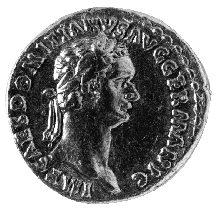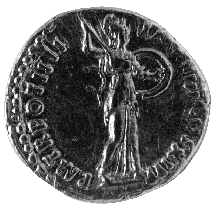



(85) Domitian - AV aureus, A.D. 85, 7.73 g. (inv. 91.152).
Obverse: Laureate head of Domitian r.; IMP(ERATOR) CAES(AR) DOMITIANVS AVG(VSTVS)
GERMANIC(VS): Imperator Caesar Domitianus Augustus Germanicus.
Reverse: Minerva advancing r., with spear raised in r. and shield in l.;
P(ONTIFEX) M(AXIMVS) TR(IBVNICIA) POT(ESTATE) IIII IMP(ERATOR) VIII CO(N)S(VL)
XI P(ATER) P(ATRIAE): Pontifex maximus, with tribunician power for
the fourth time, imperator for the eighth time, consul for
the eleventh time, father of the country.
Provenance: L.S. Werner, 1959.
Bibliography: H. Mattingly and E.A. Sydenham, The Roman Imperial Coinage
II: Vespasian to Hadrian (London 1926) 52.
Domitian (T. Flavius Domitianus), the second son of the emperor Vespasian,
succeeded his brother Titus in A.D. 81. Although he was a successful military
leader and a prolific builder, he depleted the treasury with his extravagances,
and he was an autocratic megalomaniac not unlike Nero, inspiring numerous
conspiracies before the successful plot to murder him in A.D. 96. The unusual
accumulation of titles on his coins is characteristic of his insistence
upon extraordinary honors and prerogatives.
Domitian regarded Minerva as his patron goddess, and she appears very frequently
on the reverses of his coins (see also no. 86). He built a temple dedicated
to her, she was featured on a number of monuments of his reign, and he was
even said to have kept a shrine to her in his bedroom. On the reverse of
this aureus she appears in her role as war goddess, wearing her aegis and
helmet and advancing on her invisible foe with spear and shield raised.
Domitian's portraits continue in the same realistic vein as those of his
father and brother. He shares their characteristic hooked nose, but he is
distinguished from them by his relative youth and leanness and by his protruding
upper lip.
C.L.L.



All contents copyright (c) 1996.
Lawrence University
All rights reserved.